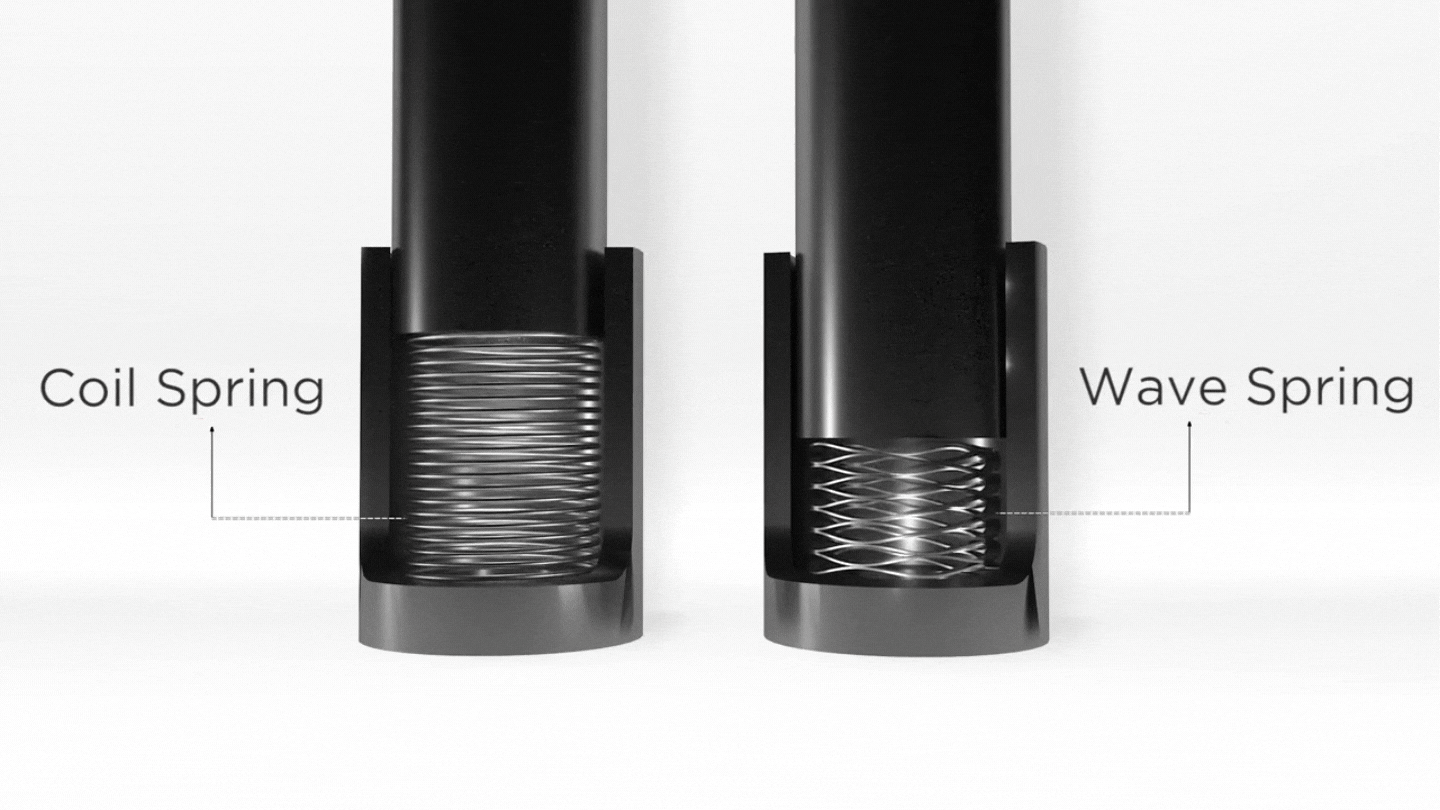Quick Connector Applications
Flatwire Wave Springs and Retaining Rings are used in a variety of quick connectors/circular plug-in connectors with threaded and bayonet locking for military, aerospace and industrial applications. The designer has the choice of single, nested and multi-turn wave springs to meet the unique demands of virtually any connector application.

Single Turn Wave Springs
A single turn wave spring with overlapping ends saves axial space so that more space is given for travel (30% more travel compared to a standard coil spring). The spring clings to the bore, which saves more radial space compared to a stamped wave washer. The overlapping ends prevent radial jamming because a circumferential movement is allowed (the spring ends could move against each other so that the specification ‘load @ work height’ is always given).
Overlapping Ends placed in the incline of a wave guarantees no scratches on the surfaces of contact.
Using rolled wire features edges with a radius which prevent scratching of the housing/shaft because no stamping burrs are the result of the coiling process of the spring. The coiling process prevents wasting material effectively and does not destroy the microstructure of the material comparing to stamping processes. The undisturbed line of force in circumferential direction based on intact metal grain offers better dynamical strength and minimizes the risk of breakage.
After connecting the male and female component of the quick connector, the wave spring provides at its work height a constant force with a tight load tolerance. This is extremely important to guarantee an exact force which is consistent enough for a continuous, safe connection.
Stainless steel and exotic materials can be easily used to provide the correct amount of corrosion resistance as required (e.g. AISI 316 stainless steel for offshore connectors).
.png?width=900&name=image%20(12).png)
Nested Wave Springs
Some quick connectors require higher forces to guarantee a certain connection because of safety regulations which were set up by the government or specified by military/aerospace guidelines. Single turn wave springs are limited in their load because of limitations regarding the wire sizes for specific diameters. For these requirements a nested wave spring could be used.
A nested wave spring provides a higher load than a single turn wave spring or a stamped wave washer and uses the same radial space as a single turn design. Overall, less radial space is needed compared to a disc spring which will also provide higher loads; travel is much higher compared to a single disc spring.
Only one part must be handled for assembly; no stacking of single turn designs, stamped parts or disc springs are necessary.

Multi-Turn Wave Springs
Using a multiple turn wave spring will offer the same advantages of a single turn wave spring but with some key differences.
Multiple turn wave springs do not cling to the bore, because radial jamming has a significant effect on the specification ‘load @ work height.’ If the design of the multi turn wave spring results in peripheral movement of the turns against each other, then this could cause problems. It could render the spring unstable because adjacent turns could become misaligned.
Compared to a single turn design bigger travel/deflection is possible because the deflection in total is split. Every turn has to tolerate less deflection compared to a single turn design. Use of a multi-turn wave spring could also result in a 50% saving in axial space compared to a traditional coil spring.
There is also no concern about torsional movements during the compression to work height as there is with a coil spring; a wave spring always provides its load in axial direction.
Very similar loads without big tolerances are provided at different work heights; in that way the application could be easily adjusted to meet given requirements.
.png?width=457&name=image%20(11).png)
2-Turn Retaining Rings & Snap Rings
Using flatwire 2-turn retaining rings and snap rings with constant sections offers additional flexibility to the designer looking to meet the specifications of a unique application.
Constant section rings do not have lugs or lug holes like traditional tapered rings. As a result, they are less likely to interfere with other components like cables or the male component of the quick connector.
ID/OD-lock function can be easily designed to generate a permanent assembly between the connector cap and inner component. Since these rings are not stamped, there are no sharp edges/burrs that could scratch soft surfaces like plastic housings.
2-turn retaining rings provide a 360° closed surface of contact, preventing soft materials like a rubber sealing element from being pushed through a gap; no local maxima of a wave spring could move into a gap so that the specification ‘load @ work height’ is influenced negatively.
AISI 316 stainless steel as a standard material offers perfect corrosion resistance for offshore applications or the chemical industry.
.png)

